In each question, there is a table having 3 columns and 4 rows. Based on the table, there are 3 questions. Each question has 4 options (a), (b), ( c) and (d), ONLY ONE of these four options is correct.
The particle is projected in projectile motion with velocity u at an angle θ with horizontal is represented by y=Px−Qx2. Answer the questions by appropriately matching the information given in the three columns of the following table.
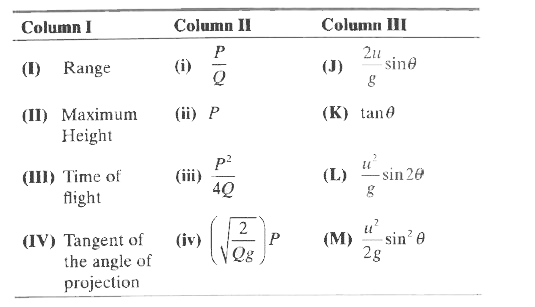
For which quantity of projectile motion P and Q are linearly dependent to each other and what is the relation between them?
(II) (iv) (K)
(IV) (ii) (M)
(III) (iii) (J)
(I) (i) (L)
The correct Answer is:D
Topper's Solved these Questions
- MOTION IN TWO AND THREE DIMENSIONSBOOK - RESNICK AND HALLIDAYCHAPTER - MOTION IN TWO AND THREE DIMENSIONSEXERCISE - PRACTICE QUESTIONS (LINKED COMPREHENSION)
14 Videos
- MOTION ALONG A STRAIGHT LINEBOOK - RESNICK AND HALLIDAYCHAPTER - MOTION ALONG A STRAIGHT LINEEXERCISE - PRACTICE QUESTIONS ( Integer Type )
3 Videos
- OSCILLATIONSBOOK - RESNICK AND HALLIDAYCHAPTER - OSCILLATIONSEXERCISE - Practice Questions
57 Videos
Similar Questions
Knowledge Check
In each question, there is a table having 3 columns and 4 rows. Based on the table, there are 3 questions. Each question has 4 options (a), (b), ( c) and (d), ONLY ONE of these four options is correct.
The particle is projected in projectile motion with velocity u at an angle θ with horizontal is represented by y=Px−Qx2. Answer the questions by appropriately matching the information given in the three columns of the following table.
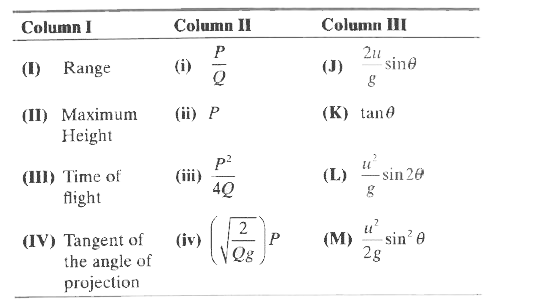
At what point is the velocity of the particle is minimum?A(II) (iii) (M)B(I) (iv) (L)C(IV) (ii) (K)D(III) (i) (J)In each question, there is a table having 3 columns and 4 rows. Based on the table, there are 3 questions. Each question has 4 options (a), (b), ( c) and (d), ONLY ONE of these four options is correct.
The particle is projected in projectile motion with velocity u at an angle θ with horizontal is represented by y=Px−Qx2. Answer the questions by appropriately matching the information given in the three columns of the following table.
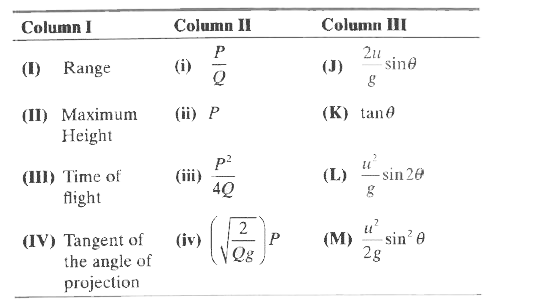
Which of the following combination shows the correct relation of quantities when total displacement of the particle is zero?A(I) (i) (M)B(III) (iv) (J)C(I) (iii) (L)D(IV) (ii) (K)The following table has 3 columns and 4 rows. Based on table there are THREE questions. Each question has FOUR options (A) , (B) , ( C) and (D) . ONLY ONE of these four options is correct
 A(III) (iv) ( R)B(I) (ii) (Q)C(IV) (iii) (R )D(I) (iv) (Q)
A(III) (iv) ( R)B(I) (ii) (Q)C(IV) (iii) (R )D(I) (iv) (Q)
In each question, there is a table having 3 columns and 4 rows. Based on the table, there are 3 questions. Each question has 4 options (a), (b), ( c) and (d), ONLY ONE of these four options is correct.

Which object has 480N⋅m as the resulting torque (as a vector)?
View SolutionIn each question, there is a table having 3 columns and 4 rows. Based on the table, there are 3 questions. Each question has 4 options (a), (b), ( c) and (d), ONLY ONE of these four options is correct.
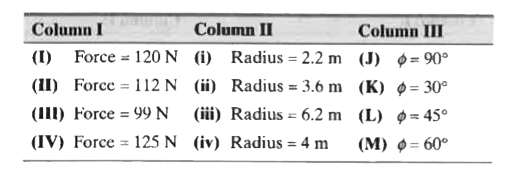
Which object has 178.2√3N⋅m as the resulting torque (as a vector)?
View SolutionIn each question, there is a table having 3 columns and 4 rows. Based on the table, there are 3 questions. Each question has 4 options (a), (b), ( c) and (d), ONLY ONE of these four options is correct.
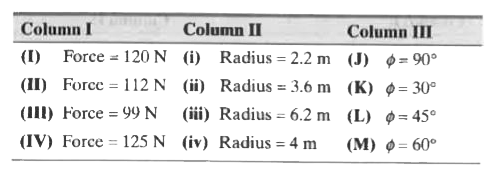
Which object has 137.5N⋅m as the resulting torque (as a vector)?
View SolutionThe following tables has 3 columns and 4 rows. Based on each table, there are THREE questions. Each question has FOUR options (A), (B), (C), and (D). ONLY ONE of these four options is correct
Q
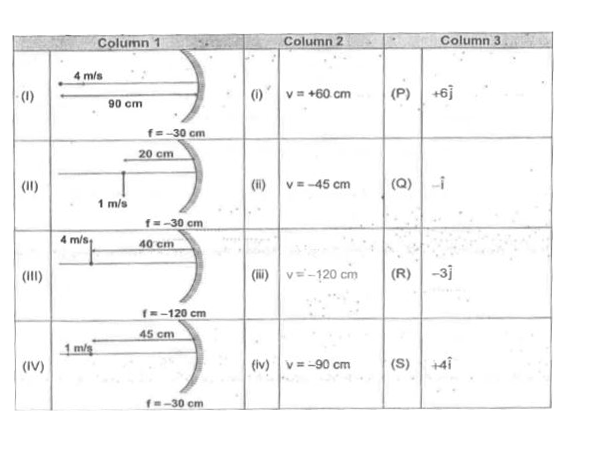
View SolutionThe following tables has 3 columns and 4 rows. Based on each table, there are THREE questions. Each question has FOUR options (A), (B), (C), and (D). ONLY ONE of these four options is correct
Q

View Solution

